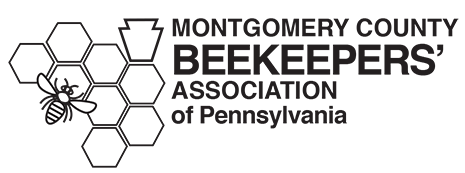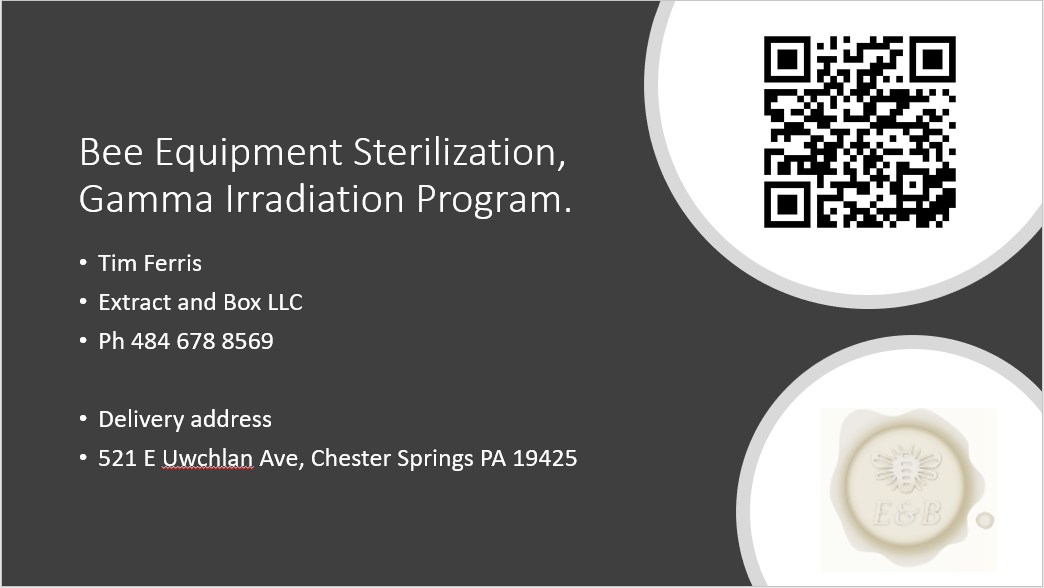Hive Equipment loading for Irradiation for American Foul Brood (AFB).Please note that MCBAPA has American Foul Brood Test Kits available. If you need some, contact Scott Famous by email at famous55@verizon.net. New Instructions! If you plan to irradiate boxes with honey in them, you must wrap them securely in heavy gauge plastic. Click here to see the new instructions. This allows PA and regional beekeepers to sterilize their hive wooden ware and other contaminated equipment using gamma irradiation. The program goals are to provide a viable, sustainable and cost effective alternative to burning hive equipment to control AFB and to allow the safe use of contaminated or otherwise suspect supers, frames and honeycomb after treatment. Plan now to irradiate your American Foul Brood (AFB) infected or potentially infected equipment. The processing is typically scheduled for early March each year in order to have equipment ready prior to the arrival of spring packages. Please contact Tim Ferris to express interest by email at ferristj@hotmail.com - his website is here. This is no longer handled by MCBA. |
|
What is American Foul Brood (AFB)?
AFB is a bacterial contamination of the hive that destroys the brood. The spore-forming bacteria Paenibacillus larvae ssp. larvae are ingested by larvae under 3 days old through the ingestion of bacterial spores in their food. The bacterial spores germinate in the guts of the larvae and the vegetative form of the bacteria feed on the larvae, killing them. The vegetative bacteria also die, but not before releasing as many as 100 million spores per larvae. Bees cleaning the contaminated cells spread the spores throughout the hive, and contaminate brood food, thus spreading the bacteria quickly throughout the hive. As the hive weakens, the hive may be robbed by invading bees, thus spreading the contamination to other hives. Similarly, beekeepers can spread the disease through their tools or transfer of hive components to other hives, or through feeding bees contaminated honey. In the spore form, the bacteria can survive for more than 40 years in honey and beekeeping equipment. Although pharmaceuticals have been developed for AFB, there is controversy for their use, as some bacterial resistance has been observed. Other methods such as scorching the interior of the hive, dipping in bleach or paraffin have also been tried, but rely heavily on adequate coverage and penetration of the affected surfaces. Therefore, prior to the advent of irradiation, the only sure control mechanism had been burning the hive and equipment.
What is gamma irradiation?Gamma irradiation is a physical means of decontamination – it kills bacteria by breaking down bacterial DNA, inhibiting bacterial division, using high-energy photons that are emitted from an isotope source (Cobalt 60). Energy (gamma rays) passes through hive equipment, disrupting the pathogens that cause contamination. These photon-induced changes at the molecular level cause the death of contaminating organisms or render such organisms incapable of reproduction. The gamma irradiation process does not create residuals or impart radioactivity in the processed hive equipment. The process has been used for years to sterilize imported leather goods, spices, wine corks, medical dressings and devices, pharmaceuticals, etc. |
What are the advantages and benefits of gamma irradiation?
ALL hive components can be sterilized using gamma irradiation – boxes, frames, comb and honey. Hive equipment is ready for immediate use after processing. The process is clean; no chemical residues are produced. Most importantly, gamma irradiation destroys, not just suppresses, the pathogens (bacteria, viruses, fungi) that may contribute to CCD and other biological threats that contaminate hive equipment. The process also eliminates the need to replace equipment or comb contaminated by American Foul Brood (AFB). There is also some evidence that gamma irradiation reduces levels of toxins (i.e., pesticides) present in honeycomb by modifying their chemical structures.
Gamma irradiation is a proven strategy – Long-standing gamma irradiation programs for hive equipment have been operating in Massachusetts, California, Florida, Canada and in Australia. While in Florida, Dave Hackenberg, one of Pennsylvania’s largest commercial beekeepers, used gamma irradiation to sterilize selected hive equipment. During Spring 2008, Penn State University cooperated with MCBAPA in the successful processing of hive equipment that was known or thought to be contaminated with AFB, IAPV and other honey bee pathogens. Subsequent testing of the processed equipment proved it to be completely clear of all biological contaminants that could have threatened our honey bees!
Where will my equipment be irradiated?The commercial facility for gamma irradiation in our area is the Sterigenics Corporation, 75 Tilbury Road, Salem, NJ 08079. This location offers beekeepers in Pennsylvania, New Jersey, New York and Delaware the opportunity to clean their known and suspect contaminated equipment. |
How do I prepare my equipment for irradiation?If you are interested in participating in our irradiation program, you will need to prepare your equipment as directed below.
**DO NOT send equipment with live ants, insects, mice, or mouse nests or other loose debris. It will be rejected from the load.**
Sterigenics will no longer allow hive equipment to be stacked and wrapped on site. Therefore, you must deliver all hive equipment properly stacked and stretch wrapped and ready to be unloaded by forklift at the facility. For processing, all collected equipment must be stacked onto standard 48″ x 40″ pallets covered with a single sheet of heavy gauge cardboard, shrink wrapped, with a top and bottom sheet of 4 mil plastic before processing by Sterigenics can occur. You must follow these necessary steps to prepare your equipment for processing:
Transporting Equipment to Sterigenics We need to have a minimum of 7 pallets of equipment get the lowest per pallet cost and make an irradiation “run” practical and economical. Persons who will be responsible for consolidating prepared equipment and delivering it to Sterigenics must follow the preparation and shipping rules below. Please note: Over the years the staff at the Salem, NJ Sterigenics facility has worked very hard to accommodate our special needs and allow us to work with them on this annual event. As a gesture of good will we have provided a 1 pound jar of local honey from each participating beekeeper to everyone on the staff at Sterigenics every year we have delivery hive equipment. Make sure you bring a jar or send a jar of honey for the kind folks at Sterigenics to whoever transports your hive equipment.
|
How long does it take to process the hive equipment?Sterigenics offers three different fee structures for the irradiation of materials all based on how quickly the materials need to be irradiated. This program uses the least expensive turnaround time which usually takes 3 – 5 business days. Same day service is three times as expensive and 48 hour service is twice as expensive. |
What are the costs and who do I contact?Please contact Tim Ferris if you have hive equipment that you wish to process at Sterigenics. Without exception, all expected processing costs for prepared pallets must be paid upon in the full amount with a certified bank check or money order made out to Sterigenics International, Inc. Note: There is a U.S. Post Office only 1/2 mile from Sterigenics where a money order may be easily purchased. If 7 or more pallets of equipment are delivered for 2020 the cost per pallet is $214.30. 1 full pallet can accommodate 48 deeps @ $4.45 per box all with frames or 66 mediums on a pallet for about $3.30 per box. Contact Information: Tim Ferris |
Help yourself and your fellow beekeepers by spreading the word about hive equipment sterilization! |

